
 Royal Navy Guided Missile Destroyers (1975-2013): HMS Sheffield, Birmingham, Newcastle, Coventry, Glasgow, Cardiff, Exeter (b2), Southampton, Liverpool, Nottingham, Manchester(b3), York, Gloucester, Edinburgh, +ARG Hércules, Santísima Trinidad
Royal Navy Guided Missile Destroyers (1975-2013): HMS Sheffield, Birmingham, Newcastle, Coventry, Glasgow, Cardiff, Exeter (b2), Southampton, Liverpool, Nottingham, Manchester(b3), York, Gloucester, Edinburgh, +ARG Hércules, Santísima Trinidad
The Type 42 class destroyers were designed in the late 1960s, in parralel to the ambitious Type 82 escorting the CV01 class carriers. This was was seen as a cheaper alternatived for fleet air defence when the program was cancelled in 1966, and fourteen constructed in three batches from 1970 to 1985, two more for the Argentine Navy. The irony was that two, HMS Sheffield and Coventry were lost in the Falklands War to the same Argentine. The Hércules class never came close enough to see action against their siblings. These ships also had a long life, until the 2010s, and were appreciated by their 84-86% average availability. This design was so successful it took succession of the County class, and were constantly improved, with the last batch (1980s) “stretched type 42”. Their successors, the Type 43 and 44, were vetoed by the treasury. #coldwar #royalnavy #sheffieldclass #type42destroyers #falklandswar
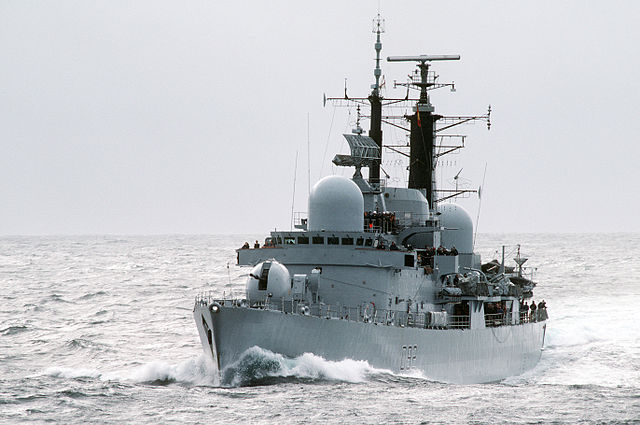
HMS Liverpool in 2008. Despite their early shortcomings, these destroyers had 35+ years careers.
Design of the class
When the CVA-01 carriers and their Type 82 air-defence destroyers were cancelled in 1966, the Type 42 were proposed as a lighter, cheaper alternative with identical capabilities. Like the former it was a carrier for the long range Sea Dart system, and be a stopper for long-range strategic bombers from the A-VMF, and area defence for carrier battle groups. However they were later criticized for both poor range and seakeeping, in the contested and temperamental north sea.
The design so still featured the same GWS30 Sea Dart SAM, but added what lacked on the Bristol, a flight deck and hangar for resident ASW helicopter instead of an Ikara system. The rest was limited to ASW TTs, a main gun, and two 20mm close defence Oerlikon guns. It was barebones, short and stocky, due to budget limits of £19 million per hull instead of the £21 million proposed. It was decided to removed 47 feet in their bow sections, making for lower beam-to-length ratio. However they innovative for the choice of all-gas turbine (COGOG) propulsion system.
However this measured causes immediate issues, as they performed poorly during contractor’s sea trials and plough heavily in heavy seas, while many other problems had to be cured. These were solved in part on the next Batch 2, still “short bow”, but with an updated sensor suite, and layout changed. From the ninth ship HMS Manchester, the hull returned to the original design, lengthened after a design review. They performed much better and subsequent ships took this as a blueprint. There were also strengthening girders to reinforced the weather deck structure, retrofitted in the batch 1 and 2 ships while Batch 3 estroyers had an external ‘strake’ to prevent longitudinal weaknesses.
Hull and general design


Profiles compared, Batch I-II (top) and Batch III (bottom).
The ships were “flush deck” with a moderate sheer forward, and a “crowded” prow section, with the gun quite close to the bow. In practice the flush deck was full up to the helideck aft, but it was open below for utility gear, inflatables and the stern sonar. The ships divered in size and tonnage also between batches:
Batch 1: 3,500 long tons (3,600 t) standard 4,100 long tons (4,200 t) full load as designed 119.5 m (392 ft) at the waterline, 125 m (410 ft) or 125.6 m (412 ft) overall
Batch 2: Same standard, but 4,350 tons full load, same waterline but 125.6 m (412 ft) overall.
Batch 3: Same standard, but 4,775 long tons (4,852 t) up to 5,350 tons full load, end of life, 132.3 m (434 ft) at the waterline, and 141.1 m (463 ft) overall
The first two had the same beam at 14.3 m (47 ft) but the Batch 3 were larger at 14.9 m (49 ft)
All three however had the same draught, of 4.2 m (14 ft) at the keel dow to 5.8 m (19 ft) at propellers level.
As for their silhouette it was “cleaner” and simpler than the Type 82. There was a two-island type superstrcture with a three decks bridge forward, singe deck after plus two level hangar. There was a single short, stocky foremast, thin aft mainmast and larger aftmast. All exhausts truncated into a single, large funnel aft amidships. They look a bit stocky but more balanced than the edgy Manchesters. The latter not only had longer bow section, but more sheer forward and a clipper, straight bow. Like the Type 82 they sported the two radomes housing fire control radars for the single SAM system.
Powerplant
For the first time, British Destroyers would have a all-gas turbine (COGOG) propulsion system, instead of a steam-gas turbine plants of past ships. For extra range despite their small size, it seemed the best option for very economical cruise. Based on two shaft five-bladed controllable pitch propellers, they both had two Rolls-Royce TM3B Olympus coupled with two Rolls-Royce RM1C Tyne marinised gas turbines in a combined gas or gas arrangement. They drove through synchronous self-shifting clutches located in a double-reduction, dual tandem and articulated, locked-train gear system. In addition if the ship was caught her turbines cold, they had four Paxman Ventura 16YJCAZ diesel generators (1 megawatt each) with 3-phase electric power of 440 Volts at 60 Hz.
HMS Sheffield, was initially fitted with exhaust deflectors on her funnel top to exhaust fumes sidewards in order to spare the aerials. However it appeared later not a good measures as is recented infrared homing missiles straight to she ship itseld. The Argentinian Hércules and Santísima Trinidad also had these deflectors. It was not corrected on the lead ship but next batch vessels had ‘cheese graters’ on their uptakes, mixing machinery space vent air with exhaust prpduced, reducing infrared signatures and still sparing the sensors.
Armament
Without Ikara, these ships still fit on a compact package a forward main 4.5 in gun, a twin arm Sea Dart SAM launcher and its reload apparatus, quite close to the bridge, which received thermal insulation at its base. The two triple TTs located aft amidships were placed on the higher structure deck, and further aft were located the chaff launchers. The two 20 mm Oerlikon guns were located two decks high with a good arc of fire, on either side of the bridge. These were exchanged later for CIWS. But by far the best innovation was their hangar housing a single Westland Lynx which had its own range of torpedoes, missiles, depth charges and sonobuoys. It should be noted that the Batch III were also to be upgraded with the Sea Wolf system, but it was never installed and they repeated the now ageing Sea Dart SAM system. The rest was identical, apart their quickly receiced CIWS.
4.5-in Mark 8 naval gun
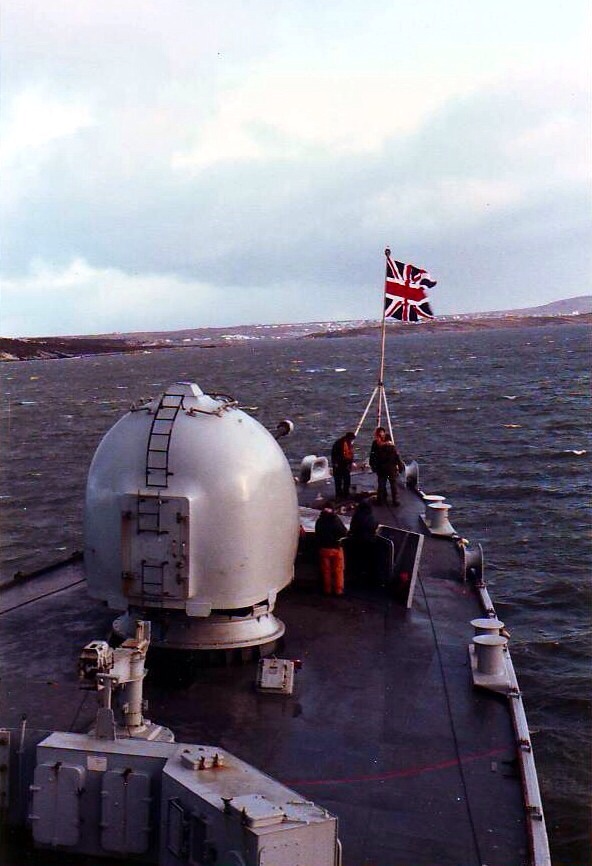
This surface/aircraft/shore targets general purpose model was designed in 1966-70 as a replacement for the venerable WW2 4.5-in/45 Mark V. It entered service in 1972, so at the same time as Batch 1 ships. It fired a 13 x 700mmR Fixed QF 46 pounds (21 kg) HE round (113 mm) at 25 rounds per minute automatic and max range 27.5 kilometres (17.1 mi).
Sea Dart
A twin launcher for GWS-30 Sea Dart missiles was install forward, with 22 missiles in storage, and the longer hulled Batch 3 had an additional 15 (so 37 in all).
The Sea Dart (GWS 30) system comprised a twin-arm launcher on the bow with coupled with a pair of radar Type 909 target illumination sets. A far cry from the previous bulky Seaslug GWS SAM of the County class. It went from the October 1960 Small Ship Integrated Guided Weapon project that would be compatible with a 3,000 ton frigate to deal with long range bombers as well as the latest anti-shipping missiles and to attack frigate size ships. Comparable to the US RIM-24 Tartar to save cost it was developed and co-financed by the Netherlands, entered service in 1970 and soldiered on all Type 42 destroyers, being retired only by 2020.

⚙ Sea Dart specifications |
|
| Weight | 550 kg (1,210 lb) |
| Dimensions | 4.4 x 0.42, wp 0.9m (14 ft x 17 in x 3.0 ft) |
| Warhead | 11 kg (24 lb) HE blast-fragmentation, Proximity fuze and contact |
| Engine | Chow solid-fuel booster motor + Bristol Siddeley Odin ramjet cruise motor |
| Range, mod 0 | 40 nmi (46 mi; 74 km) |
| Flight ceiling | 18,300 m (60,000 ft) |
| Maximum speed | Mach 3.0+ |
| Guidance | Semi-active radar illuminated by radar Type 909 (J-band) |
Anti-Aicraft
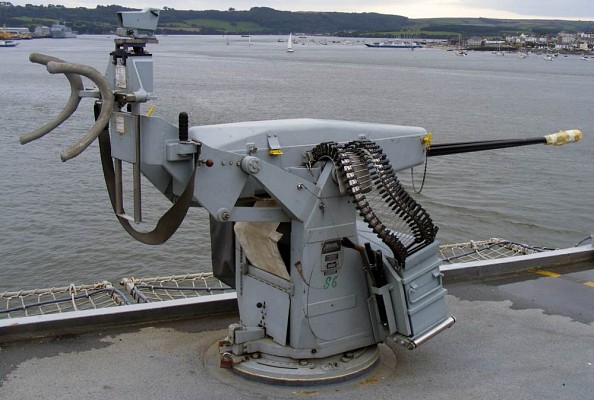
In the Falklands, Sheffield was found afoter the failoure of the sea dart and 4.5 in gun, down to its last measure, the two 20 mm Oerlikon AA guns, way too short against jets, and… small arms. So these systems were upgraded twice postwar.
At first these ships had two Oerlikon 20 mm L70. Postwar, in 1985-86, BMARC 20 mm L/70 KBA guns, placed in GAM-B01 single mounts replace them. They were located immediately after the bridge’s wings, close to the captain and staff. Despite superior accuracy compared to WW2 stock Oerlikons, they still were not adequate to deal with sea-skimming missiles and were more of the close quarter asymetric response. They were removed and replaced by two twin 30mm/75 GCM-A032 in the mid-1980s for some and two six-tubes 20mm/76 Mk 15 Phalanx CIWS relocated on wing platforms abaft the funnel. It saw action for support gunfire during the Falklands war with also the sinking of the Argentine transport ARA Isla de los Estados.
The BMARC 20mm (photo above) replaced the venerable Oerlikon with simple shield after the Falklands war. In service by 1985 these British mounts were developed from the early 1980s by British Manufacture and Research Company, still using as a core the updated Oerlikon Contraves KAA autocannon, modified in a new cradle mount under the military designation A41/820. Its Cyclic rate was ported above 900 rpm while the mount has an ininterrupted 200 round belt. Range is the same, 2 km against surface targets, 1.5 km versus aerial targets.
In turn they were replaced by the CIWS, which possessed a greater firepower, notably against incoming antiship missiles.
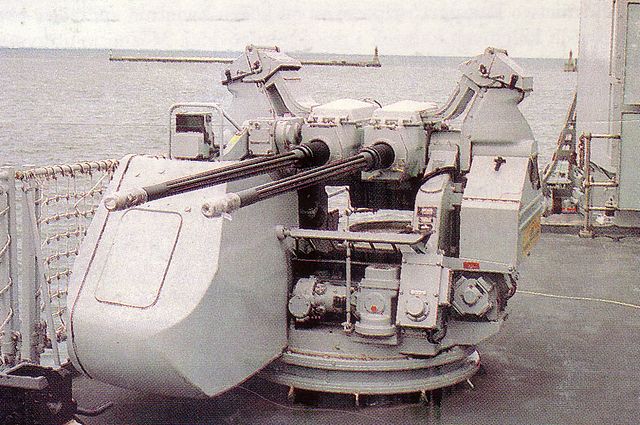
The 30mm/75 GCM-A032 was part of the Oerlikon KCB family, an upscaling to 30 mm of its venerable AA gun, after the acquisition of Hispano. It was well used in France from the late 1950s onwards and was also produced by BMARC under the name 032. The Royal Navy adopted these as twon mount, electrically operated and using automatic targeting systems. It was capable of 600 round/min with a muzzle velocity of 1,080 m/s (3,500 ft/s) and an effective firing range of 3,000 m.
Torpedo Tubes
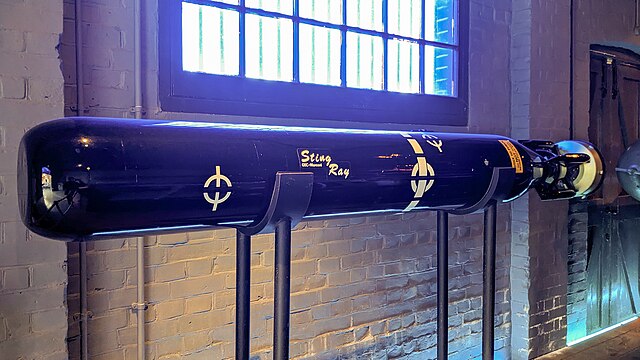
The post-Falklands Sting Ray Torpedo, here at the explosion museum
These STWS II triple anti-submarine torpedo tubes were very similar to the US equivalents, with three short tubes mounted in a triangle. They fired the same ordnance as the USN Mark 32 system, the Mark 44 and 46 homing 12.75 inches torpedoes and after modernization, the stingray torpedo. On subsequent destroyers the latter became fixed broadside tubes.
The Stingray (1983) was developed by GEC-Marconi (now BAE Systems). It weighted 267 kg (589 lb) for 2.6 m (8.5 ft) in lenght and 330 mm (13 in) in diameter, had a max range of 11 km (12,000 yd) and carried 45 kg (99 lb) of torpex, powered at 45 kn (83 km/h) with her Electrical pump-jet powered by Magnesium/silver-chloride batteries and using Active and passive sonar. It could be deployed also by the Lynx, as the Mark 44/46.
Westland Lynx Helicopter
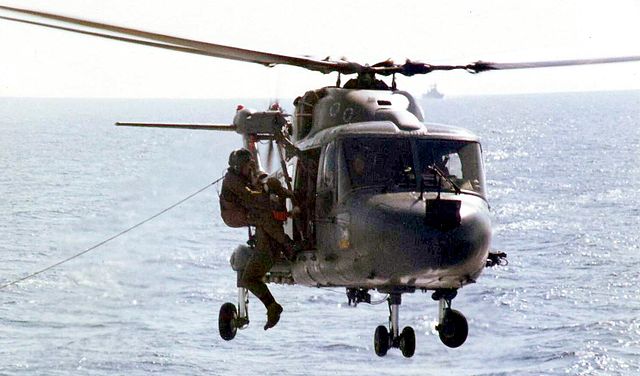
The Westland Lynx HAS/HMA was also a brand new platform when these ships entered service. They greatly improved their long range detection/strike capabilities for ASW.
The Lynx was a Westland-Aerospatiale project initially, supported and later used also by the Marine Nationale. It met quite a large export success, with dozens of variants. In its original configuration on the Type 42 destroyers, it could operate with four Sea Skua anti-ship missiles, two depth charges, or carry two anti-submarine torpedoes of the type compatible with the triple TT banks. The Sea Skua was a 25 km range, Mach 1+ Semi-active radar homing missile. These proved very precious during the life of the destroyers at two occasions: In the falklands, by claiming a submarine and many smaller vessels, and in the Gulf war, teaming with USN HH-60 Seahawks which had better sensors in hunter-killer teams, tracking down Iraqi vessels and smugglers.

Sea Skua Missile. It could also be deployed from the deck of many ships using a simple tripod cradle.
Sensors
The electronics suite comprised chiefly the Type 1022 D band long-range radar and its LFB track extractor, alternative to a Type 965P long-range air surveillance radar and a Type 996 E band/F band 3D radar for target indication also with LFA track extractor and the type 992Q surface search radar for navigation. The most visible were two Type 909 I/J-band fire-control radars combined with LFD radar track.
Radar Type 1022/965P air surveillance:
Radar Type 996/992Q 3-D surveillance:
Two radar Type 909 GWS-30 fire-control (radomes):
Navigation Radars Type 1007 & 1008:
IFF 1016/1017:
Sonar Type 2050/2016 for passive search:
Sonar Type 162 for bottom profiling:
Electronic warfare: One UAA2/UAF and a DLH decoy system
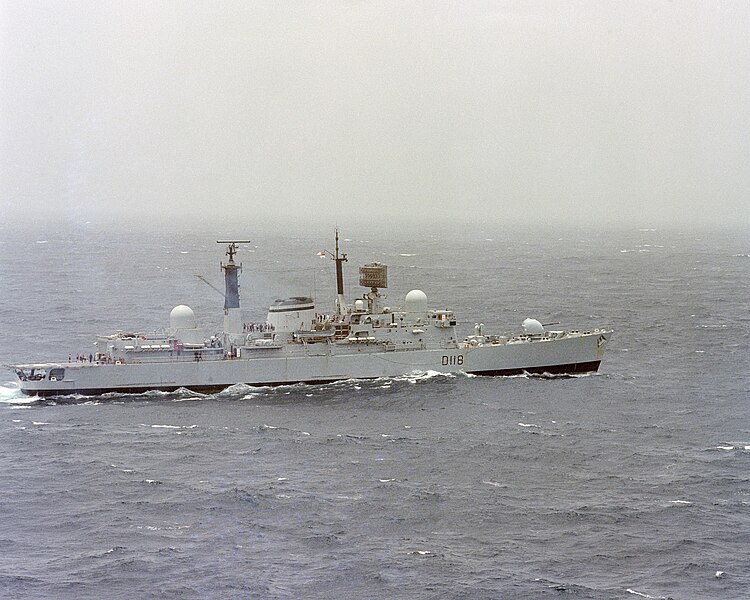
Design Modifications
In 1982, just after combat deployment in the Falklands, HMS Birmingham received two twin 30mm/75 GCM-A03 mounts and two single 20/90 GAM-B01, and Newcastle, Glasgow, Cardiff, Exeter, Southampton saw the removal of their mediocre Corvus decoy RL for the same AA and four DLD decoy Rocket Launchers. Circa 1985-86, Birmingham and Nottingham saw their original 20mm/70 Oerlikon removed in turn for the same two singe 20mm/90 GAM-B01.
Newcastle, Glasgow, Cardiff before 1989 saw the removal of their 30mm/75 but also of their aging radar suite, the type 992Q, and type 965M radars, as well as their type 184M sonar, and type 670 ECM suites and ADAWS-4 CCS.
The upgrade package now consisted in two 6-tubes gatling 20mm/76 Mk 15 Phalanx, replacing all AA mounts. In addition the electronics suite now comprises the type 996, type 1022, two Mk 90 radars, a type 2016 sonar, and the type 675 ECM suites. They also received the new type 182 torpedo decoy as well as a complement against missiles, two DEC laser dazzlers, and an ADAWS-7 CCS.
In her 1987-1989 refit, HMS Birmingham received two twin 30mm/75 AA and the type 965M (AKE-2) radars, as well as a type 184M sonar. She was also upgraded with the type 670 ECM suites, and the ADAWS-4 CCS, Phalanx, and the type 1022, Mk 90 radars and type 2016 sonar, and UAA of type 2 and the type 675 ECM suites, and type 182 torpedo decoy, same DEC laser dazzlers and ADAWS-7 CCS.
During the same period, Exeter, Southampton, Liverpool and Nottingham had about the same upgrade, but gained the type 996 radar and type 2050 sonar, type 182 torpedo decoy and DEC laser dazzlers.
There was no upgrade until 2000, survivors saw the removal of their torpedo tubes, of their type 1006 radar, type 675 ECM suite. They were reequipped with the new type 1007 and type 1008 radars.
Exeter and Southampton replaced their UAA(2) ECM suite for an UAT(5) ECM suite and a year layer, Newcastle, Exeter, Southampton, and Liverpool lost their remaining 20 mm Oerlikon AA guns.
Some also had their DLF(2) floating decoy launchers removed, and the type 182 torpedo decoy and DLF(3) floating decoy launchers added of the type 2070 torpedo decoy system.
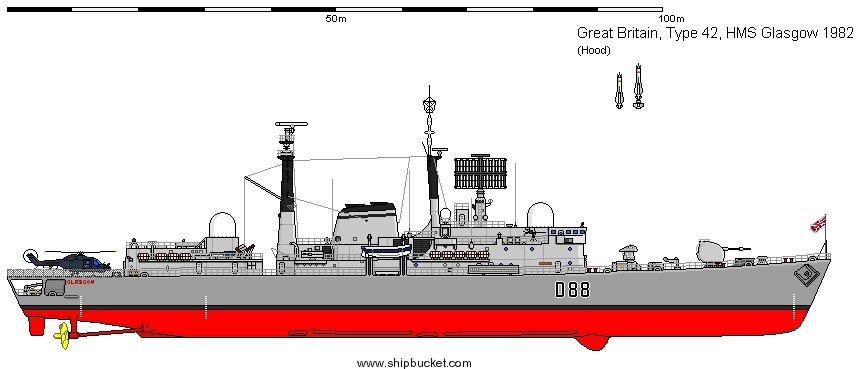
Glasgow in 1982
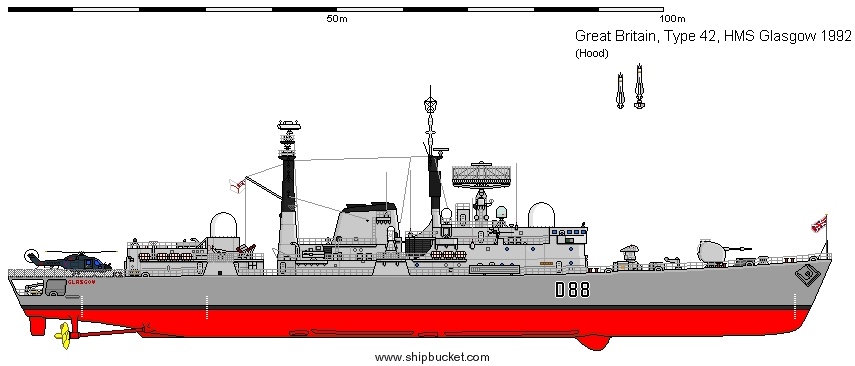
Glasgow in 1992, both: shipbucket forum, Batch I type
⚙ Batch I specifications |
|
| Displacement | 3,500 long tons standard, 4,350 tons FL |
| Dimensions | 125moa x 14.3m x 4.2m (410 x 47 x 14ft) |
| Propulsion | 2 shafts COGOG, 2xRR Olympus TM3B HSGT, 2× RR Tyne RM1C CGT (50,000 shp + 5,340 shp) |
| Speed | 30 kn (56 km/h; 35 mph) |
| Range | 4,200 nmi (7,800 km; 4,800 mi) with single Tyne RM1C 13.8 kn |
| Armament | 1×2 GWS-30 Sea Dart SAM, 4.5 in gun, 2× Oerlikon L/70, 2× STWS II TTs, Westland Lynx HAS/HMA |
| Sensors | Type 1022/965P, Type 996/992Q 3D, 2× Type 909 GWS-30 FCR Type 1007 & 1008 nav, IFF 1016/1017, Sonar Type 2050/2016, Type 162 bottom profiling, UAA2/UAF and DLH decoys |
| Crew | 24 officers, 274 ratings, accommodation for 312 |
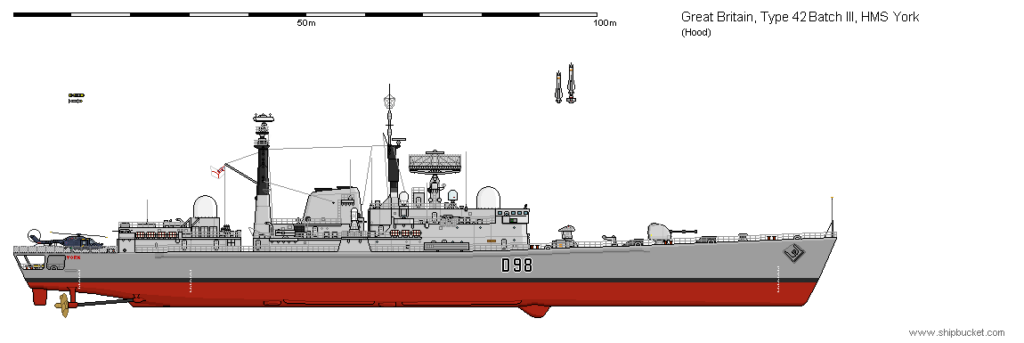
The “long hulled” HMS York of Batch III, shipbucket.
⚙ Batch III specifications 2000s |
|
| Displacement | 3,500 long tons standard, 5,350 tons full load |
| Dimensions | 132.3 m (434 ft)wl, 141.1 m (463 ft)oa x 14.9 m (49 ft) beam |
| Armament | 1×2 GWS-30 Sea Dart SAM, 4.5 in gun, 2×3 TTs STWS II/stingray, 2×20 mm Phalanx CIWS, Westland Lynx HAS Mk.III |
| Sensors | type 1007, type 1008, Mk 90 radars, type 2016 sonar, type 675 ECM suites, type 182 torpedo decoy, 2xDEC laser dazzlers, ADAWS-7 CCS |
| Crew | 301 1993, 269 in 2013 |
Evaluation
General Career
This class was seen as the main fleet barrier for long-range strategic bombers of the Soviet A-VMF, as well as carrier battle groups area defence duties. Seven took part in the Falklands War (Operation Corporate) and aftermath. And they indeed provided this long-range defence against the Argentine air force with three confirmed kills. HMS Sheffield was hit and disabled by an Exocet missile and the damage was such she sank six days later whereas Coventry was sunk by conventional bombs. Glasgow was badly damaged also by a bomb which went down to her engine room without detonating, but post-battle reports led to an extensive rework of the class’s protection definciencies. Some were retroactively applied so they could see service in The Gulf War: HMS Gloucester managed to down a land-based SSN missile. These destroyers also served in the West Indies anti-drug patrols, Falkland Islands patrol, as well as taking part in many NATO Mediterranean and Atlantic operations and exercizes. They were ultimately replaced by Type 23s in high-intensity areas as indeed on the long run both service and reliability issues reduced these destroyers availability, and eventually their againg combat systems/machinery.
Overall costs and retirement
They were, despite their size and intents, still a costly lot: In May 1982, the Parliamentary Under-Secretary of State Jerry Wiggin evaluated their replacement cost to be circa £120 million. By July 1984, the Parliamentary Under-Secretary of State John Lee affirmed their average cost was £117 million at the time. Of course costs would rise due to inflation over the years: Construction cost of HMS Sheffield by 1975 was £23,200,000. D97 HMS Edinburgh ten years later was rated as high as £130,600,000. Maintenance costs were average with a dry service cost of £10.0 million in the early 1980s, £15 million yearly, including £7 million in the later 1980s for the personnel, fuel, spares, administrative services. However refits costs in 2007–08 amounted to £31.35 million per ship on average. Based on availability grounds, by February 1998, MoD Dr Reid declared
Type 42 destroyers achieved approximately 84 to 86 per cent average availability for operational service in each of the last five years. This discounts time spent in planned maintenance.
Apart the two ships lost in the Falklands, HMS Birmingham was sold for scrap on 20 October 2000, and the last, HMS Edinburgh, decommissioned on 6 June 2013 and later sold for scrap.
Battle analysis: The case of Sheffield and Coventry
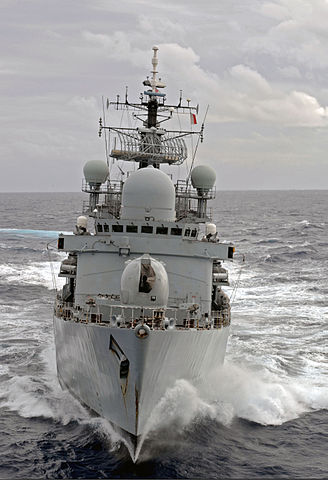 At 4 May, c10:00 AM, HMS Sheffield was at defence watches, in second degree readiness as the southernmost of three Type 42 (with HMS Glasgow and Coventry) as advanced anti-aircraft picket 18-30 miles west of the main task forc (HMS Invincible) south-east of the Falklands. There was a calm sea state, with 2-metre swell and Invincible managed for them the Anti-Air Warfare Coordination (AAWC). Sheffield was to relieved Coventry whch had issue with her Type 965 radar. However Sheffield’s radar operators used to not distinguish between Mirage and Super Étendards, the latter being armed with deadly Exocet missiles, and some pointed out the potentially outmoded IFF/radar jamming and looked at the exocet threat as overrated and a false alarm. It should be added that the Type 965 could not detect low-flying aircraft, and thus misses the two Argentinian exocet-armed Super Etendard approaching at 98 feet (30 m). They were only detected at 40 nautical miles (74 km) by the UAA1 radar warning receiver and conformed by the 965M long range warning radar of HMS Glasgow as both climbed to 120 feet (37 m) to fire their missiles, at 45 nautical miles (83 km). HMS Glasgow went to action stations and radioed ‘Handbrake’ to the task force. These radar contacts were also picked up by Invincible, sending Sea Harriers to inverstigate, but they missed them. This led to declaring these radar contacts as false, degrading Air Warning to “yellow”.
At 4 May, c10:00 AM, HMS Sheffield was at defence watches, in second degree readiness as the southernmost of three Type 42 (with HMS Glasgow and Coventry) as advanced anti-aircraft picket 18-30 miles west of the main task forc (HMS Invincible) south-east of the Falklands. There was a calm sea state, with 2-metre swell and Invincible managed for them the Anti-Air Warfare Coordination (AAWC). Sheffield was to relieved Coventry whch had issue with her Type 965 radar. However Sheffield’s radar operators used to not distinguish between Mirage and Super Étendards, the latter being armed with deadly Exocet missiles, and some pointed out the potentially outmoded IFF/radar jamming and looked at the exocet threat as overrated and a false alarm. It should be added that the Type 965 could not detect low-flying aircraft, and thus misses the two Argentinian exocet-armed Super Etendard approaching at 98 feet (30 m). They were only detected at 40 nautical miles (74 km) by the UAA1 radar warning receiver and conformed by the 965M long range warning radar of HMS Glasgow as both climbed to 120 feet (37 m) to fire their missiles, at 45 nautical miles (83 km). HMS Glasgow went to action stations and radioed ‘Handbrake’ to the task force. These radar contacts were also picked up by Invincible, sending Sea Harriers to inverstigate, but they missed them. This led to declaring these radar contacts as false, degrading Air Warning to “yellow”.
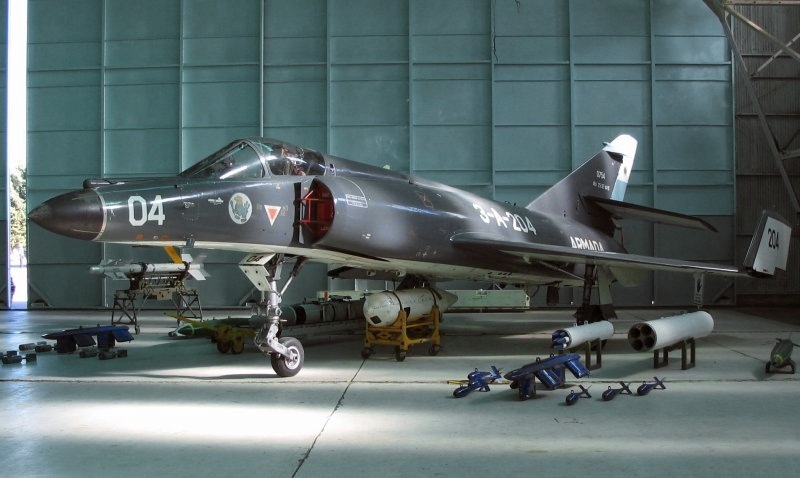
On all three destroyers however crews of the 4.5 inch gun, Sea Dart and 20 mm guns were all at maximum battle stations. In the end, Sheffield detected them by her forward Type 909 radar when its UAA1 sensor was blocked by an unauthorised transmission by a satcom transmission and the data link from Glasgow failed. Seven seconds later, a first Exocet missile arrived, with chaff being launched. Sheffield’s lookouts only detected its smoke when the Exocet was already too close there was not time to call the captain for an evasive manoeuver or action stations, and neither the 4.5-inch gun,Sea Dart missiles or chaff systems were ready, with the antiair warfare officer in the operations room only after the first hit…
The second Exocet launched was picked up by HMS Yarmouth and splashed into the sea 0.5 miles (0.43 nmi) off Sheffield’s port beam. But the first hit her on her starboard side at deck level 2, going through the junior ratings’ scullery and into the Auxiliary Machinery Room bulkhead, just 2.4 metres (7.9 ft) above the waterline. The explosion and resulting hole was 1.2 metres (3.9 ft) by 3 metres (9.8 ft), and disabled all electrical distribution systems as well as rupturing the sea water fire main, and thus, the fire system severely, dooming the ship from that point. The hole was not enough to sink her indeed.
None of the most important commissioned officers for the ship’s AA response were present: The the captain was off duty in his cabin and the anti-air warfare officer (AAWO) was in the wardroom chatting to the stewards. His assistant was in the heads. Soon afterwards as the hit was conformed, flagship HMS Hermes dispatched escorts Arrow and Yarmouth to investigate plus an helicopter. Meanwhile Sheffield launched its own Lynx helicopter to Hermes with the air operations officer and operations officer abopard to confirm the ship’s status.
After the fire main has been disabled, the crew was left fighting with portable powered pumps and even buckets, in poor cohesion and coordination and no emergency HQ made for the crew. HMS Arrow and Yarmouth rushed out to assist with their own fire mains to little effect, port and starboard. The crew battled the fires for four hours before Captain Salt ordered to abandon ship as the firese were creeping to the Sea Dart magazine. At this point his ship was non-operative and he wanted to extract Arrow and Yarmouth from an exposed position. All knew the Argentines had three more of these aircraft and missiels. Most of Sheffield’s crew evacuated into HMS Arrow, or by helicopter to Hermes. To try to raise morale, Sub-lieutenant Carrington-Wood started to sing monthy Python’s life of Brian’s “Always Look on the Bright Side of Life” which the evacuees followed.
Until 4 May 1982, the ship drifted but did not exploded. There were five inspections made to observe her status, until it was decided to patch up her hole and tow her to South Georgia. She in fact had been even earlier under tow by HMS Yarmouth but high seas that trigerred slow flooding until she had a list to starboard and eventually rolled over and sank under 6,000 ft (1,800 m) on 10 May 1982. Related by the press in big letters it was seen as a schock only comparable at the time as the loss of Hood by Bismarck in May 1941.
20 of the crew went with her. They were mainly on duty in the galley and computer room, caught by the explosion and fierce fire. 26–63 were also injured mostly from burns and smoke inhalation. A single body was later recovered.
As part of the board of enquiry looking after the case postwar, many suspected her superstructure made from magnesium-aluminium to be responsible for the propagation of fire, until it was proved with plans and data was mild steel was used instead. Indeed both USS Belknap and HMS Amazon had such compopsite structures and suffered from heavy fires and this was compounded by the sinking of the Type 21 frigates Antelope and Ardent which had aluminium alloy superstructures. However one consequence was to ban nylon and synthetic fabrics for British sailor’s safety combinaisons, and went back to non-synthetic materials to avoid severe burn injuries in the future.
The board of enquiry also pointed out the main reasons for this defensive failure:
-Not answering to HMS Glasgow’s detection and communication to action stations, Sea Dart and launching chaff decoys being activated.
-Lack of adequate ECM jamming capability, unable to defeat the exocets’s homing radar.
-Lack of a fast, automated point defence system (as CIWS)
-Inadequate operator training for low-level target acquisition.
-Slow response of the Type 909 Sea Dart tracking radar.
No fire control redundancy and poor control to to ignitable material coverings, curtains, sealing, shortage of breathing apparatus.
-Too small forward escape manholes to allow escape when wearing a breathing apparatus.
And about the doubts on if the missile indeed detonated inside, this was later confirmed in 2015. By 2017, a complete copy of the previously confidential report was declassified and republished partially by The Guardian. Some of the personal found guilty of gross negligence and possbly court martialled were left unadressed by fear of curtailing the victory euphoria after the war, as well as other revelations by fear of impeding possible sells aboard of the Type 42s at the end of their service.
In the end, the case of HMS Sheffield, if paid dearly, was a gift to postwar missile defence adjustments and measures, passed on to the next destroyers of the Type 45 (Daring class) in the late 1990s-2000s as well as new frigates.
The Argentinian Hércules class
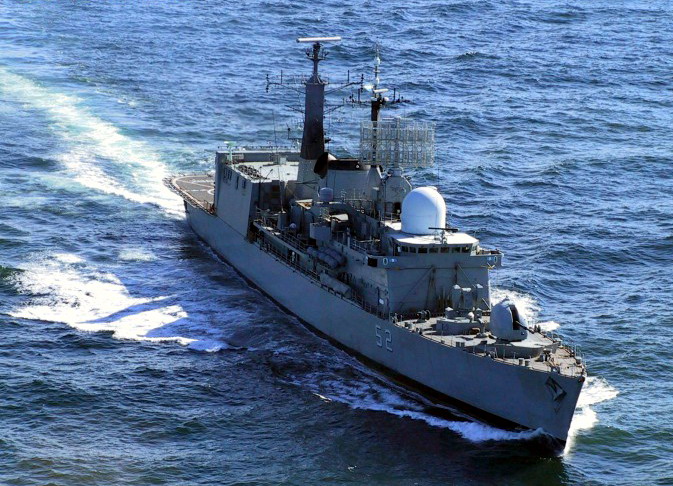
To escort the Veinteicinco de Mayo, the Argentinian Naval Staff ordered to Britain two of the Type 42, Batch 1:
D-1 (later B-52) Hércules Puerto Belgrano built at Vickers Shipbuilders Ltd, Barrow-in-Furness, 18 May 1970, laid down on 16 June 1971 and launched 24 October 1972, completed on 10 May 1976 and commissioned on 12 July 1976. She was transformed in a multi-purpose transport ship from 2000 and is non-operational by 2020. Hércules for her conversion to amphibious command ship got a new aft superstructure and hangar, fitted with four Exocet canisters, either side of the funnel, removed during this refit.
D-2 Santísima Trinidad was made on British plans AFNE, Rio Santiago, Argentina, ordered 18 May 1970, laid down 11 October 1971, launched 9 November 1974 but completed by 1 July 1981. She was like her sister based at Puero Belgrano, and was decommissioned in 2004. Plans to have her converted as a naval museum never materialized as she sank due to poor conditions off Puerto Belgrano on 22 January 2013. Refloated in December 2015, she moved to a drydock to evaluate restoration possibility, but the coast was too great. She was scrapped in 2018-2020.
Read More/Src
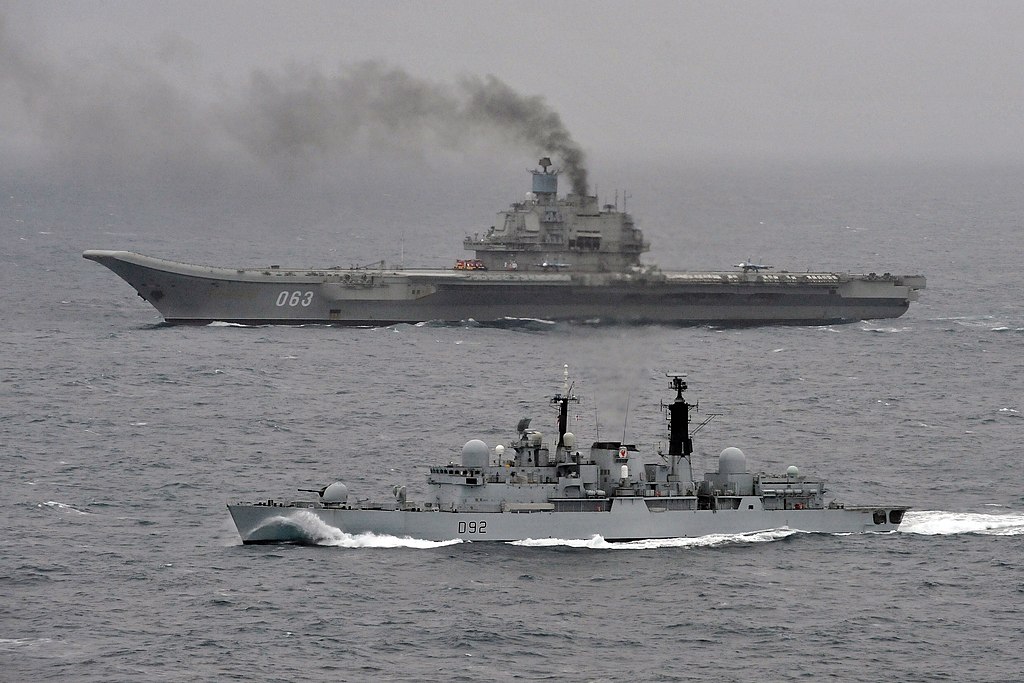
HMS Liverpool shadowing Admiral Kuznetsov in British waters.
Books
Conway’s all the world’s fighting ships 1947-95
Moore, John Jane’s Fighting Ships, 1982–83, pub Jane’s Publishing Co Ltd, 1982
Marriott, Leo Modern Combat Ships 3, Type 42, pub Ian Allan, 1985
Marriott, Leo: Royal Navy Destroyers since 1945, ISBN 0-7110-1817-0, Ian Allan Ltd, 1989
Aldrich, Richard James Intelligence, Defence, and Diplomacy: British Policy in the Post-War World. Taylor & Francis, pub 1994
Sharpe, Richard, Jane’s Fighting Ships 1992–93, pub Janes Information Group, 1992
Heyman, Charles The Armed Forces of the United Kingdom 1999–2000, pub Pen and Sword, 1998
A Preston. Sea Combat off the Falklands. Willow Collins. (1982)London, pp. 112–113
Links
on navypedia.org/
on en.wikipedia.org
on nao.org.uk
telegraph.co.uk
www.bbc.com/
https://web.archive.org/web/20090718204212/http://hansard.millbanksystems.com/written_answers/1982/may/27/royal-navy-ships-replacement-costs#S6CV0024P0-08145
commons.wikimedia.org/
web.archive.org/ royalnavy.mod.uk/
navweaps.com BMARC 032 GCM 30mm AA
Videos
Also:
another doc with 1980s footage
Falklands Type 42/22 in combat
ALL OF ONE COMPANY” HMS COVENTRY ROYAL NAVY 1980s RECRUITING FILM 48274
Model Kits
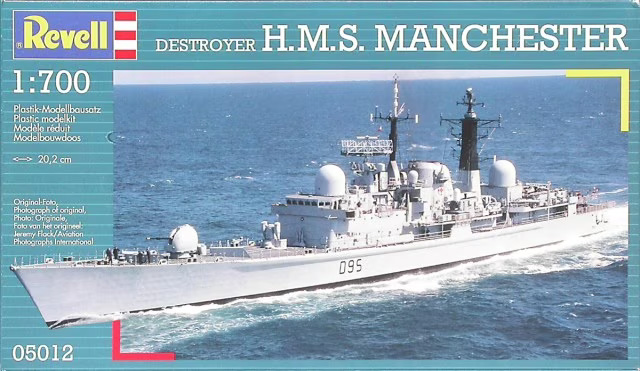
Fortunately for modellers, the falkland war helped push forward the sall of models on an otherwise niche subject. General query on scalemates.
Some examples: Atlantic Models 1:350 and Cyber Hobby, DML, Dragon, Galaxy and Pit-Road, Revell and S-Mars 1:700 among others.
3D
 D80 Sheffield
D80 Sheffield
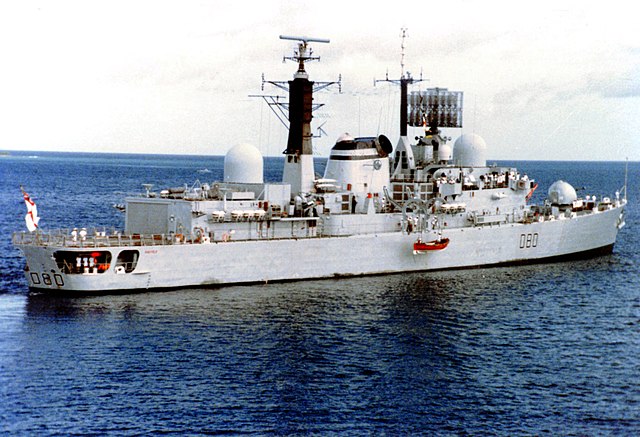
She was built at Vickers Shipbuilders Ltd, Barrow-in-Furness, ordered 14 November 1968 laid down 15 January 1970, launched 10 June 1971, completed on 16 February 1975. In June 1981, she participated in Exercise Roebuck and fired five Sea Dart missiles. Next she took part in Ocean Safari and by November 1981 started patrols in the Indian Ocean and Persian Gulf.
Captain James Salt took command at Mombasa on 26 January 1982 and had little previous experience in surface ships or air defence, with with his XO based on submarines prior.
In March 1982 she crossed the Suez Canal and sailed to the Atlantic for Exercise Spring Train. After the Argentine invasion of the Falklands she was ordered on 2 April 1982 to join the task force assembled, and fully prepared for combat operations. This including getting rid of unnecessary furniture, carpets and other flamable materials. To avoid confusion with the Hércules and Santísima Trinidad was painted a vertical black marking on the funnel and down to the waterline for air recognition.
She was underway on 2 April, reached Ascension Island on 14 April with HMS Arrow, Brilliant, Coventry, Glasgow and the supply ship Appleleaf, and the group joined later Task Force 317 in the Total Exclusion Zone on 1 May 1982.
At the time, she was instructed in case of missile threat to tale evasive manoeuver at top speed and firing chaff (‘handbrake’). The dotation of the Argentines of the Super Etendard’s own Agave radar was signalled by the French for recoignition, to be picked up. However there were more concerns about the Navy’s Type 209 submarine, especially after the loss of General Belgrano. All three destroyers were ordered to change course every 90 seconds in patrol.
Sheffield was spotted at first by an Argentinian Lockheed SP-2H Neptune at 07:50 on 4 May 1982 and shadowed her and nearby destroyers, reporting her at 08:14 and 08:43. Two Argentine Navy Super Étendards took off (piloted by Capitán de Fragata Augusto Bedacarratz, Teniente Armando Mayora), each with one AM39 Exocet from Río Grande NAS at 09:45, were refuelled in flight by a KC-130H Hercules tanker at 10:00 and proceeded to th elast known position at low altitude. These elite pilots made good of their previous training targeted at the weaknesses of the Type 42 destroyer’s sensors with their “Pecking the Lobes” technique.
At 10:35, the SP-2H Neptune climbed to 1,170 m (3,840 ft), detecting two destroyers reported to the Super Étendards underway. At 10:50 they rose to 160 metres (520 ft) to pick up the contacts but failed and went back to low altitude and did the same latter. They were also picked up by some RN ships during the manoeuver.
Coordinated were fed to the Exocet’s weapons systems and missiles were fired at 11:04 c20-30 miles away, and broke off, returning to base.
In case of an encounter with patrolling Harriers, there was an Argentine Air Force Learjet 35 acting as radar decoy plus two IAI Daggers escorting the KC-130.
One Exocet hit HMS Sheffield as described above. After burning furiously for days water while under tow in heavy weather flooded the hull through the hole close to the waterline until she sank, carrying 20 sailors previous kills inside after the explosion. She became the first Royal Navy ship sunk since WW2.
 D86 Birmingham
D86 Birmingham

Built at Cammell Laird & Co, Birkenhead, Birmingham was ordered on 21 May 1971, laid down on 28 March 1972, launched by 30 July 1973 and completed on 26 November 1976, commissioned on 3 December 1976. Birmingham teamed up with HMS Ardent in the Persian Gulf, Armilla patrol, watching over oil supplies delivered during the Iran–Iraq War in 1980. She became later the first Type 42 to have new Sea Dart missiles loaded at sea. She became Fleet Contingency Ship and was not mobilized as part of the Falklands Task Force. She resumed post-Falklands patrols and by 1984 went to the Falklands as a radar picket with the frigates Broadsword and Ajax. In 1985 she was reassigned to the Standing Naval Force, Mediterranean, from Gibraltar and patrolling to Palma de Mallorca in the West as well as Naples and Messina in the east. She was refitted at Rosyth and homeported to Portsmouth in 1988, under command of Roy Clare, for a deployment to the Persian Gulf and back in March 1989.
In July 1990, she was rushed to join the RFA Oakleaf from Florida to Trinidad after the Jamaat al Muslimeen coup attempt but arrived aft the hostages were released. She was ultimately paid off at Portsmouth on 10 December 1999, sailed to Devonport in 2000, was stripped of usable equipment and towed back to Portsmouth, stricken and sold for scrap, which was done in Spain from 20 October 2000.
 D87 Newcastle
D87 Newcastle
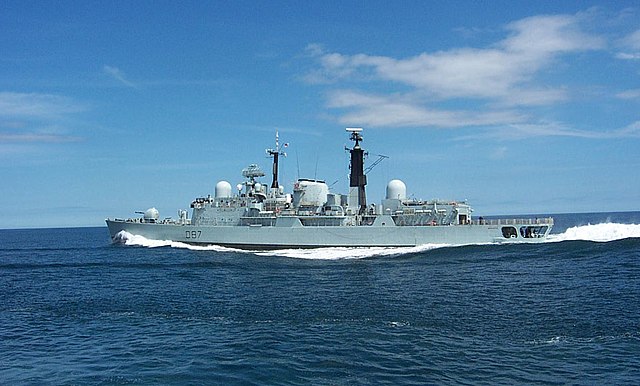
Built at Swan Hunter Ltd, Wallsend-on-Tyne, ordered 11 November 1971, laid down 21 February 1973, launched 24 April 1975 and completed 25 February 1978, commissioned on 23 March 1978. She teamed up with Glasgow, Sirius, Phoebe, and RFA Olmeda in the the Falkland war by August 1982, between patrols and radar picket duties. On 12 May 1992, she took part in the Orient ’92 group (flag HMS Invincible) with HMS Boxer, Norfolk and RFA Olwen in the Far East and for Joint Exercises in the Malacca Straits, visiting the Seychelles, Singapore, Hong Kong, Japan, Philippines and back by 27 November.
In 1993 she was in Battle Griffin ’93 in the northern fjords (Norway) and multiplied Escort missions. On 8 September 1993 she headed for the Southlant, and became a Falkland Islands Guardship, stopping to Abidjan. She was relieved by HMS Scylla (Leander class frigate) and headed for the Patagonian Canals, stopping at Valparaiso, Callao and Port of Spain, then Ponta Delgado and back to Portsmouth on 8 April 1994. She made a goodwill visit, celebrating the Newcastle United FCs and playing ‘Goggles Must Be Worn’. She had a refit starting in Rosyth by July 1995 and into 1996. By November 1997, she became Guard ship in the Caribbean and for counter narcotics operations with a US Coast Guard Miami’s Law Enforcement Detachment (LEDET). She also assisted the population of Montserrat after the volcanic eruption and was back in Portsmouth on 10 July 1998.
In 1999, she escorted HMS Invincible to Kosovo, covering raids on Serbian targets. In 2002 she started a six-month Atlantic Patrol, stopping at Sierra Leone, then the Mediterranean in January 2004 for a 7-month deployment. She was decommissioned on 1 February 2005, sold and scrapped.
 D118 Coventry
D118 Coventry
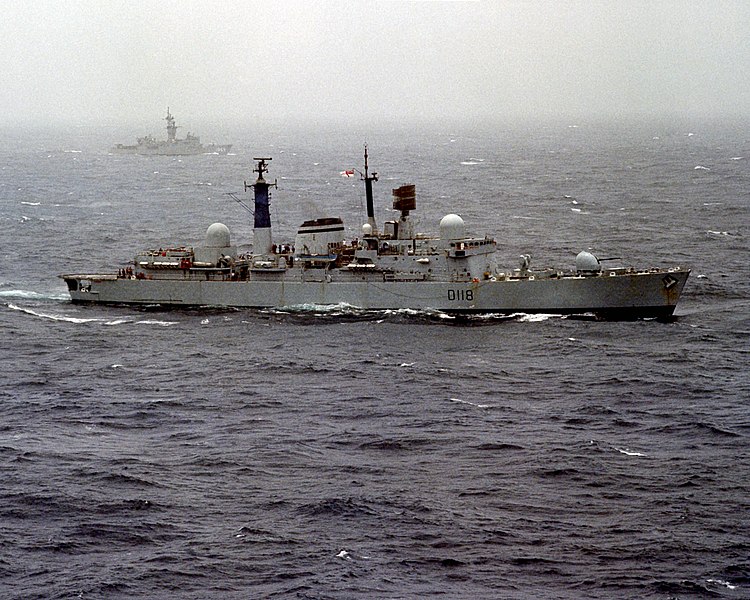
Ordered at Cammell Laird & Co, Birkenhead on 21 May 1971, laid down 29 January 1973, launched 21 June 1974, completed on 20 October 1978 and commissioned on 10 November 1978. Coventry started service under command of Captain C. P. O. Burne, at Portsmouth. She tested the new Westland Lynx helicopter, helping to define its limits. Sge made a first deployment in 1980 to the Far East and HMS Antrim and Alacrity, visiting the People’s Republic of China (first in 30 years). She was rerouted to the Persian Gulf to patrol the rear sea during the Iran–Iraq War for six weeks, relieved by the Armilla patrol (Ardent and Apollo). Until 1982 she took part in exercises close ot home, notably Exercise Springtrain ’82 in March 1982. She was scheduled to take part in a intelligence-gathering mission in the Barents Sea and fitted with special communications monitoring equipment but by March she was at the British base of Gibraltar, requisitioned for the Falklands War, with a Union Flag painted on the bridge’s roof, black line painted from the funnel top down to the waterline. On 27 April she was deployed with Glamorgan, Glasgow, Arrow and Sheffield in the total Exclusion Zone around the Islands and as air defence vanguard.
Her helicopter Westland Lynx HAS.Mk.2 used its Sea Skua air-to-surface missiles for the first time on 3 May, disabling the ARA Alferez Sobral. She destroyed her bridge, made eight killed, eight wounded. She would remain in service until 2018, her bridge removed and displayed at the Naval Museum in Tigre, Argentina. She was also the first to fire Sea Dart in action on 9 May at two Learjets of Escuadrón Fénix, but missed. Captain David Hart Dyke, claimed two A-4C Skyhawks of Grupo 4 were shot down by Sea Darts but in realioty they were lost to bad weather, however she would have later a confirmed kill on a Aérospatiale Puma helicopter (601 Assault Helicopter Battalion) with a Sea Dart over Choiseul Sound.
After the loss of Sheffield and damage to Glasgow on 12 May she remained alone to defend the task force. Later the two remaining Type 42s joined the two Type 22 frigates, deployed ahead of the main force, combining the Sea Darts and short range Sea Wolf. She was paired with HMS Broadsword.
On 25 May 1982, Coventry and Broadsword moved to north-west of Falkland Sound as decoy to draw Argentinian aircraft away from San Carlos Bay. With the land making a barrage to radar waves, the Sea Dart were less effective and they later spotted FAA A-4B Skyhawk C-244 of Grupo 5. One was shot down by a Sea Dart over Pebble Island and later another A-4C Skyhawk of the same Grupo, deployed to San Julian, was also claimed east of Pebble Island.
However they were attacked by two waves of two A-4 Skyhawks carried a 1,000 lb free-fall bomb each or 3 x 250 kg bombs and arriving too low to be picked up. Broadsword attempted to fire her Sea Wolf but her own tracking system could not be reset before they were over them. One of the large bombs bounced off the sea, struck Broadsword’s flight deck but failed to detonate. But she lost her Lynx helicopter. Coventry claimed to have hit the second Skyhawk but it returned safely home. The second pair followed 90 seconds later. Failing to obtain a missile lock, Coventry launched a Sea Dart as distraction and turned hard to starboard while Broadsword could not her Sea Wolf as Coventry’s turn made her too close.
HMS Coventry thus fired her 4.5-inch gun, even small arms, as the port Oerlikon 20 mm cannon (which jammed) and she was struck by three bombs above the water line, port side. One destroyed her computer room, operations room, and wounded all senior officers. One hit her forward engine room and she started to list to port. Her bulkhead between the forward and aft engine rooms was breached and wast followed was an uncontrollable flooding. After 20 minutes she was abandoned and capsized, sinking afterwards. The destroyer had 19 killed, 30 injured and Broadsword rescued 170 of her crew.
 D88 Glasgow
D88 Glasgow
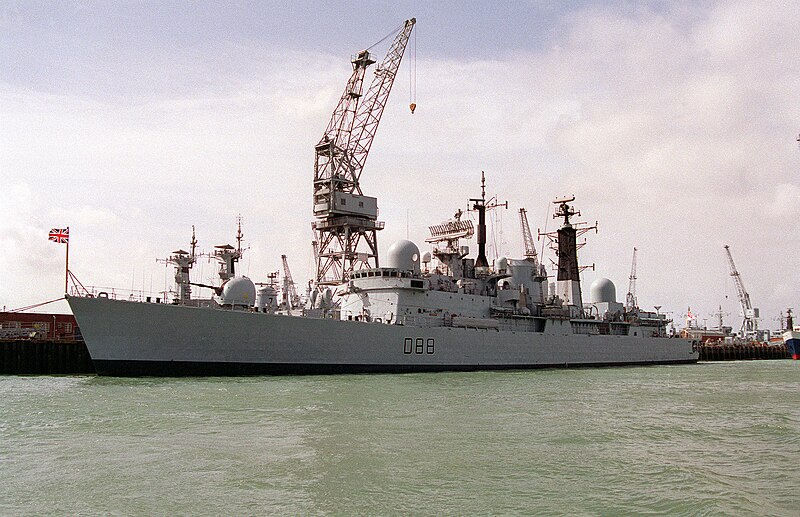
She was ordered at Swan Hunter Ltd, Wallsend-on-Tyne on 11 November 1971, laid down 16 April 1974, launched 14 April 1976, completed on 9 March 1979 and commissioned on 24 May 1979. Early in gher service she was rammed by the Soviet cruiser Admiral Isakov on 27 May 1981 in the Barents Sea while collecting intel on Soviet hardware. She became one of the five Type 42 destroyers assembled to take part of the Falkland Islands campaign in April-May 1982. She was about the fiest to arrive in the 200 nm (370 km; 230 mi) exclusion zone.
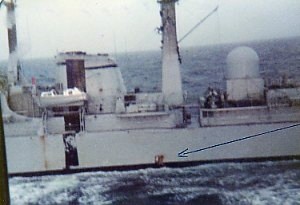 HMS Glasgow came from Gibraltar, the assembly point for 18 Royal Navy frigates and destroyers of “Exercise Spring Train”. She was ordered south with Antrim, Arrow, Brilliant, Coventry, Glamorgan, Glasgow, Plymouth and Sheffield, with stores, fuel and ammunition already in Gibraltar. On 2 May, her Lynx helicopter fired missiles at Alferez Sobral, badly damaged. On 4 May, Glasgow detected an Exocet missile and warned the fleet but Sheffield failed to receive the warning. Glasgow and Coventry were now the only long-range defence of the fleet. A new air defence tactic was implemented by pairing each with Type 22 frigates. They completed each other for long/sjort SAM range and were deployed afar to draw attacking aircraft away from the carrier groups. Glasgow paired with Brilliant. This picketing tactic was successful for the task force but less to draw these Argentinian fighters away from San Carlos Bay, repeatedly attacked. They shelled Argentinean positions and then waited for the aircraft to come.
HMS Glasgow came from Gibraltar, the assembly point for 18 Royal Navy frigates and destroyers of “Exercise Spring Train”. She was ordered south with Antrim, Arrow, Brilliant, Coventry, Glamorgan, Glasgow, Plymouth and Sheffield, with stores, fuel and ammunition already in Gibraltar. On 2 May, her Lynx helicopter fired missiles at Alferez Sobral, badly damaged. On 4 May, Glasgow detected an Exocet missile and warned the fleet but Sheffield failed to receive the warning. Glasgow and Coventry were now the only long-range defence of the fleet. A new air defence tactic was implemented by pairing each with Type 22 frigates. They completed each other for long/sjort SAM range and were deployed afar to draw attacking aircraft away from the carrier groups. Glasgow paired with Brilliant. This picketing tactic was successful for the task force but less to draw these Argentinian fighters away from San Carlos Bay, repeatedly attacked. They shelled Argentinean positions and then waited for the aircraft to come.
On 12 May, Glasgow and Brilliant in their “42-22” were posted 15 miles SW of Port Stanley. At 11:00 Glasgow started bombarding Argentinian positions but this afternoon they were surprised by a wave of four A-4B Skyhawks of Grupo 5. The destroyer’s Sea Dart and 4.5 inch Mk.8 gun both failed but Brilliant’s Sea Wolf managed to shot down two, the third colliding with debris. However a second wave of Grupo 5 Skyhawks and this time Brilliant’s Sea Wolf failed, they dropped three bombs. One passed clean through Glasgow’s aft engine room but did not detonated. Fuel systems were ruptured and the two Tyne cruising engines were damaged. A third wave was detected but they went elsewhere. The one that dropped the bomb, Lt Gavazzi was shot down by friendly fire over Goose Green and he holed the hull 3 feet above the waterline starboard. Damage control teams plugged the hole, however the exit hole was near-impossible to access behind the machinery and closer to the waterline. She was patched and considered no longer fully operational, running at 10 knots and returned home to Portsmouth. She was only back to the South Atlantic after the end of the war by August 1982
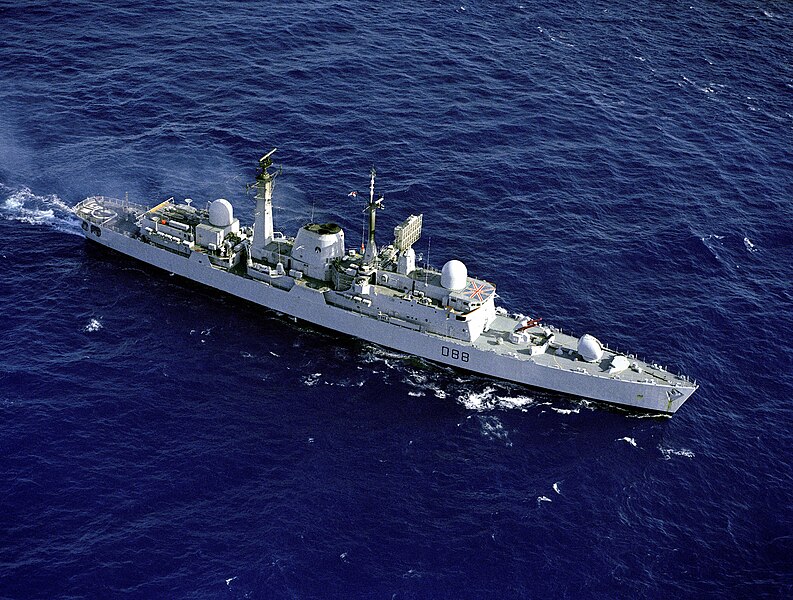
Postwar she was assigned to the West Indies Guard Ship (WIGS) in 1987 and had a major refit in Rosyth by 1988–89 with her machinery being replaced, weapons and sensors upgraded and obtaining 30mm Phalanx. In 1990 she visited New York and Toronto. In 1991 she was part of the ARMILLA Patrol after the Gulf War. In 1992 she was deployed with STANAVFORMED. Next she was deployed to East Timor as part of INTERFET for peacekeeping from 19 to 29 September 1999. By early 2004 she was back in the South Atlantic Patrol. By July 2004 she was announced to be decommissioned in January 2005. On 7 January 2009 she was towed Turkey for BU.
 D108 Cardiff
D108 Cardiff
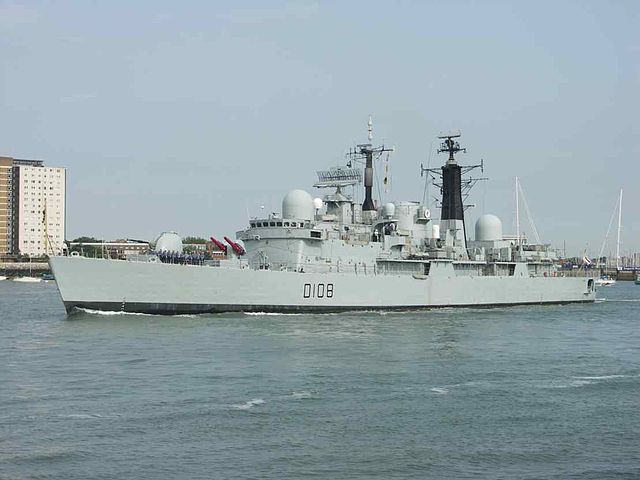
She was ordered 10 June 1971 to Vickers Shipbuilders Ltd, laid down 6 November 1972, launched 22 February 1974 but completed at Swan Hunter Ltd, Hebburn on 22 September 1979 and commissioned on 24 September 1979. Under Captain Barry Wilson she made long trips over 12 months and over 21,000 kilometres (13,000 mi) and she visited her namesake city, welcoming 7,000+ on board. In 1980, she attended annual Navy Days at Portsmouth/Portlan hosting 17,300 visitors. In October she made trip to Ghent, Belgium and made Sea Dart exercises off Aberporth, South Wales. By 2 April 1982, Under Captain Michael Harris she was interrupted in her six-month Persian Gulf deployment, Armilla Patrol. She relieved her Sheffield and was herself redeployed to the Falklands on 23 April via Gibraltar, arriving on 14 May with the Bristol group.
Underway she multiplied training exercises, air attacks, NBC protection, drills against Exocet anti-ship missiles and an identification stripe was painted like other Type 42 destroyers. On 22 May she decected and launched her Sea Darts at an Argentine reconnaissance Boeing 707 at 11:40, at maximum range, one fell short, the second missed due to evasive manoeuvres. The B707/TC-92 later dropped below radar level back to El Palomar. On 25 May, Cardiff recovered four SAS troopers dropped previously by a C-130 Hercules. The Bristol group joined the task force on 26 May and Cardiff’s arrival allowed Glasgow to return home for repairs. Cardiff became long range SAM picket and was detached for shore shelling with her 4.5-inch gun; In one she landed 277 HE rounds.
She witnessed the final Exocet raid against Invincible. However in the early hours of 6 June she shot down a friendly Gazelle (656 Squadron) believed to be an enemy C-130 Hercules. It was the result of poor communication between the army and navy and IFF transmitter being turned off due to interferences with other equipment. It was not over. One hour after this incident, Cardiff spotted four landing craft carrying with 2nd Battalion Scots Guards. After enquiry she was told there were no other British forces in the area and she started to fire illuminating star shells before firing. Fortunately, when realising the destroyer’s intentions, the officer in charge of this firce, Major Ewen Southby-Tailyour decided to return to shallow water and try to outrun her. Cardiff signalled “friend” via Aldis lamp, to what Southby-Tailyour responded with “to which side”. Cardiff decided to left them alone and voided another incident.
On the morning of 13 June, two Argentine Dagger attacked Cardiff’s Lynx helicopter (829 NAS) while searching in the Falkland Sound in poor weather. She made evasive manoeuvres and dodged the attacks. Cardiff later shot down the last Argentine aircraft in this war, with a Sea Dart, a Canberra bomber B-108 (Grupo de Bombardeo 2) en route for Port Harriet House. Captain Pastrán managed to eject but navigator Captain Casado was killed.
Argentina surrendered on 14 June, Cardiff being detached herself to accept the surrender of a 700-strong Argentine garrison in Port Howard, West Falkland and she remained in the area by June as Landing Area Air Warfare Controller around San Carlos.
In total she fired nine Sea Dart, one Mk 46 torpedo. Back home on 28 July 1982, she went into a long maintenance and received twin Oerlikon 30 mm port and starboard for AA protection and later by Phalanx CIWS.
Cardiff als took part in the Gulf War. She was part of a combined naval force entering the Persian Gulf, sailing north to destroy the Iraqi Navy and providing naval gunfire support and mine counter-measure before the main landings. Back in May 1990, she returned to Group X-Ray, with Brazen, London and Gloucester, relieving Armilla Group Whiskey (Battleaxe, Jupiter, York). Cardiff and Gloucester provided protection for USS Bunker Hill, Princeton and Worden as well as Midway, Ranger and Theodore Roosevelt. She also took part in boarding operations. Her Lynx worked in combination with US Seahawks as the second lacked an effective anti-ship missile but had more extensive surveillance capability. They were to track down enemu ships and disposed of them with Sea Skua missiles. 600 sorties were performed and many kills.
Cardiff’s Lynx (815 NAS) was more active in effect than her destroyer carrier, and by 24 January 1991, she spotted Iraqi minesweepers and landing craft taking part in the Battle of Khafji. She attacked and sank one and this was the first successful British naval engagement. Later she was in operations off Qaruh Island and five days later operated with Lynxes from Gloucester and Brazen, destroying two Iraqi FACs exiting the Shatt Al Arab. She destroyed others in February and were relieved by Group Yankee (Brave, Brilliant, Exeter, Manchester).
Later she was part of Standing Naval Force Mediterranean, took part on counter-narcotics ops. West Indies, took part in a relief effort on the island of Eleuthera after Hurricane Andrew. From 1993 to 1994, she was commanded by Richard Leaman and retruned to the Persian Gulf for 7 months.
On 14 October 1994 she took part in Operation Vigilant Warrior with HMS Cornwall, an operation going on until 21 December 1994. She took part in 1995 NATO “Strong Resolve” and underwent an Operational Sea Training (OST) at Portland and attended the 50th VE Day anniversary in Copenhagen, Oslo. In Plymouth she trialed her weapons and took part in Operation Bright Star in Egypt. In November she entered Beirut, a first in 27 years and visited Tunisia.
In 2000 she took part in Atlantic Patrol Task North, six months in the Caribbean, helping the disaster-stricken island of Caye Caulker near Belize. By October she was with NATO “Unified Spirit”, off the US coast. She started her last Armilla patrol in early 2003 in the Persian Gulf, stopping £2 million of illegal cargo from exiting Iraq, inspecting 178 vessels, seizing more than 25,000 tonnes of oil, and relieved by HMS Richmond, back to Portsmouth on 4 April and at the end of the year taking part in Sea Days demo exercise. By 2005 she was at the Trafalgar 200 International Fleet Review, scheduled to be replaced in 2009 by Daring, first of the Type 45 destroyer but was decommissioned earlier due to a white paper, by 14 July 2005, staying in Portsmouth, Fareham Creek and cannibalised. By 21 November 2008 she was sold to a Turkish shipbreaker and was towed to Aliağa for scrapping.
 D89 Exeter
D89 Exeter
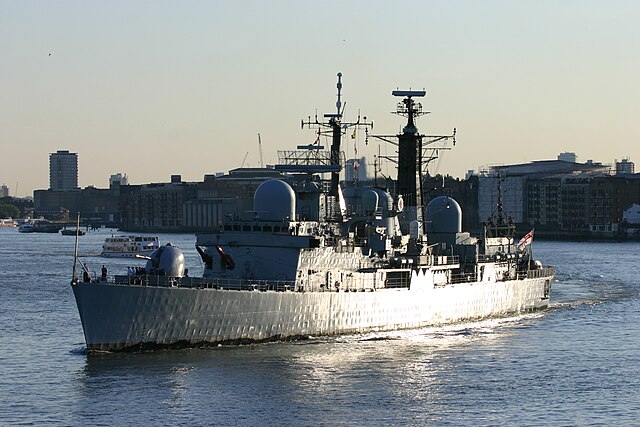
HMS Exeter (Batch II, and following) was ordered to Swan Hunter on 22 January 1976, laid down 22 July 1976, launched 25 April 1978, completed on 30 August 1980 and commissioned on 19 September 1980. In 1981 HMS London fired the last Mk 1 Sea Slug missiles for Exeter to calibrate her new radars and better work out her Sea Dart against, high and low targets. She was unique in having a turquoise hull below the waterline, an experimental co-polymer paint in non-standard colours for testing. Its light-blue ‘boot topping’ on the waterline ended in standard brick red/black after the Falklands War. She was indeed deployed in the Falklands from the Caribbean after the loss of Sheffield and shot down three Argentine aircraft, two A-4C Skyhawks on 30 May, a Learjet 35A on 7 June with Sea Dart missiles, redeeming the missiles after initial lack of success. She also claimed an Exocet missile on 30 May. She was until 1984 under command of Captain Hugh Balfour.
She also served in Operation Granby (1991 Gulf War, Captain Nigel Essenhigh) and provided air defence for US battleships in their shelling mission.
In 1997-98 she had a major refit in Rosyth and after post refit trials resumed Sea Training and made a Joint Maritime Course firing her missiles by June 1999. By September she joined the Armilla patrol in the Persian Gulf, stopped in Dubai for the Millennium and was relieved by the Illustrious Task Group by February 2000.
She also attended the 25th-anniversary commemorations of the Falklands War in Newquay by 2007. By May 2008, she promoted the launch of a new James Bond novel in London, “the day before Devil May Care” with a mock speedboat attack and Lynx circling around.
On 30 July 2008, she entered an ‘extended readiness’ in Portsmouth, decommissioned by 27 May 2009 but still use to train naval base tugs. She was sold for BU on 28 March 2011, towed to Leyal Ship Recycling in Turkey, 23 September 2011.
 D90 Southampton
D90 Southampton
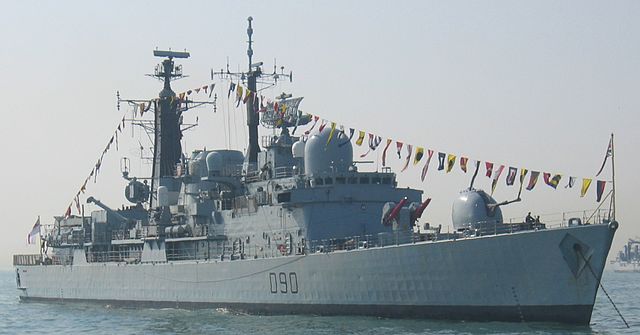
HMS Southampton was from Vosper Thornycroft, ordered 17 March 1976, laid down 21 October 1976, launched 29 January 1979, completed 17 August 1981 and commissioned on 31 October 1981. In late 1983, she ran over a Shambles Buoy off Portland during her preparation for the Falklands, which sent her in dry dock for repair. She made a six months deployment in the Falklands guard ship and by 3 September 1988, she was in the Armilla Patrol, persian gulf, when colliding with MV Tor Bay, a container ship escorted through the Straits of Hormuz. Three were injured and she ship had a 10-metre (33 ft) hole to be patched into her hull, but she was lifted in a semi-submersible heavy lift ship and carried back to UK that way for major repairs.
Logs missing until 2006. By 3 February she took part in a record seizure (3.5 tonnes) of cocaine in the Caribbean as part of the RN cooperation against drug trafficking.
On 31 July 2008, she was in “Extended Readiness”, decommissioned on 12 February 2009, sold for BU on 28 March 2011, towed to Turkey by 14 October 2011 for scrapping.
 D92 Liverpool
D92 Liverpool

She was ordered to Cammell Laird on 27 May 1977, laid down 5 July 1978, launched 25 September 1980, completed on 12 May 1982 and commissioned on 1 July 1982. She was prepare to join the task force to the Falklands by early June 1982 but it ended and her departure was cancelled, instead she became a trial ship and she later spent six months on station and back by the Spring 1983. In 1987 she was off the north coast of Russia (data collection on Soviet naval missile launched). In 1988 she was modernized in Rosyth (Phalanx) and the next year joined the Armilla Patrol in the Persian Gulf and in 1990 and 1993. Alternated with NATO standing force Mediterranean. After the eruption of the Soufriere Hills Volcano by 1995 she evacuated the population of Montserrat, part of the 7,000 evacuees to Antigua and Barbuda.
8 September 2002 saw her launching the last Sea Darts since a decade 250 miles (400 km) SW of the Isles of Scilly against a sea skimming target after her last refit in Rosyth and she was part of Naval Task Group 03 for far east exercises (Five Power Defence Arrangement) and Persian Gulf, 2003 Iraq War. 2005 saw her back in drug patrols in the Caribbean, but by 2008, 18 sailors onboard tested positive for cocaine. She had her last refit in 2009 and by 2010, she escorted the fleet flagship HMS Ark Royal for four-month deployment to the US-Canada (Exercise Auriga), and by March 2011, she relieved HMS Cumberland in the Med for Operation Unified Protector off Libya during its civil war.
On 18 April, she intercepted MV Setubal Express en route for Tripoli, and sent a boarding party, confiscating trucks possibly usable by Gaddafi regime. On 12 May 2011 while off Misrata, HMS Liverpool was fired upon by a shore battery, without hit. She helped intercepting high-speed inflatable craft off Misrata used for laying mines and was also targeted by shore rocket artillery, silencing it with her 4.5 inch main gun. On 28 June 2011, she fired warning shots when pro-Gaddafi maritime forces approached Misrata, and they were forced back. She was targeted again on 3 August and silcenced the battery with her main gun after a barrage of illumination rounds for an air attack on Zlitan. On 16 August she did the same and was fired upon by a Loyalist shore battery, silenced again, and destroyed a convoy spotted by a patrol aircraft with 54 shells, NATO aircraft finishing the job. She was back from Unified Protector on 7 November into Portsmouth.
On 7 February 2012 she shadowed a Russian task group led by Admiral Kuznetsov into the Channel, and up to south-west Ireland back from the Black Sea to the Northern and Baltic Fleets. By March 2012 she took part in Exercise Cold Response, winter war game in northern Norway, escorting HMS Illustrious and HMS Bulwark. She visited her namesake city on 29 February 2012, opened to the general public and was formally decommissioned on 30 March 2012.
 D91 Nottingham
D91 Nottingham
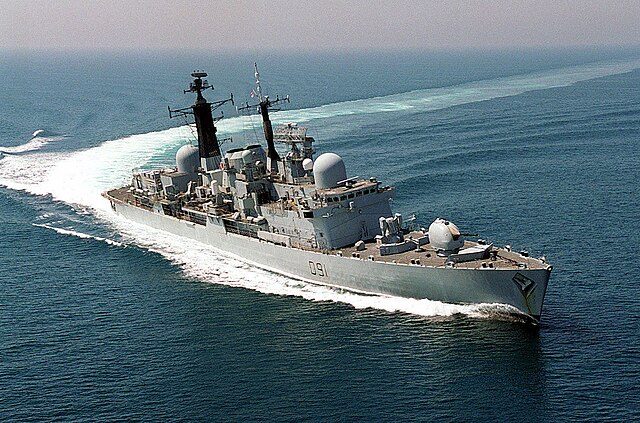
HMS Nottingham was ordered to Vosper Thornycroft on 1 March 1977, laid down on 6 February 1978, launched 18 February 1980, completed on 22 December 1982 and commissioned on 14 April 1983. She made a her first cruise to Oporto, in Portugal, Gibraltar loosing two sailors, drowning while on shore leave in Oporto. By November 2000 she had a a major refit to extend her service to 2012, but decommissioned in 2010. By 7 July 2002, she ran aground on the submerged Wolf Rock near Lord Howe Island off Australia in poor weather. She had a 160-foot (49 m) hole, five compartments flooded, and was miraculously saved by her safety team. She was helped by HMNZS Te Mana and HMNZS Endeavour for 2–3 weeks when stuck. Navigational error by the XO was pointed out (captain ashore). She was assisted by the SALMO team and crew, stabilized and patched to return to Newcastle (North of Sydney) by 6 August, towed stern-first due to her mushed bow. In Australia she had her Sea Dart missiles removed, repaired and then went to Sydney on 15 October, lifted on the heavy lifting MV Swan to be carried back to UK for extra repairs and modernization. She arrived on 9 December at Portsmouth until 7 July 2003 after a £39m repair and refit. By 23 August 2004 she met SAS Mendi (Valour-class frigate, South African Navy) for commermorations about the WW1 sunken troopship SS Mendi.
By April 2008, she entered “extended readiness” at Portsmouth, was decommissioned on 11 February 2010, sold on 28 March 2011, and ended at the same Leyal Ship Recycling facility in Turkey as her sisters.
 D95 Manchester
D95 Manchester
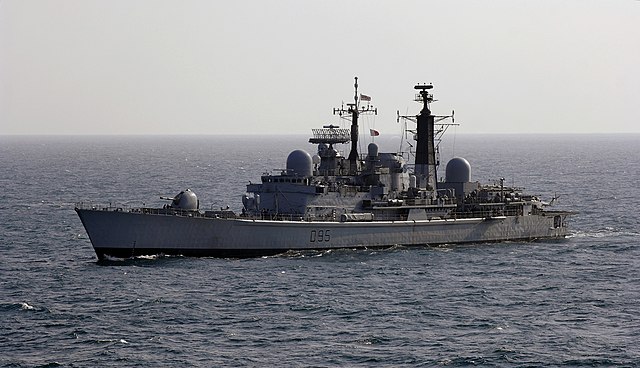
D95 Manchester (Batch III) was ordered at Vickers on 10 November 1978, laid down 19 May 1978, launched 24 November 1980 and completed on 19 November 1982, commissioned on 16 December 1982. She had a mixed crew, 50% from Sheffield and Coventry, both sunk at the Falklands. She sailed there in 1983/84. She took part later in Royal Navy’s Global 86 tour with Illustrious TG in a serie of port visits. Sge was later versed to the 5th Destroyer Squadron and by 1988, took part in Operation Armilla with the frigates Jupiter and Beaver and visited by Margaret Thatcher, following her tour of India. She watched over developments in the Iran-Iraq war. In 1991 she took part in several operations of the First Gulf War, with the trade and won this battle honour. By February 2000, she was deployed in the Atlantic Patrol Tasking (North) and Caribbean for counter narcotics with RFA Grey Rover and USS Deyo, US LEDET stopping at Key West, Barbados, St Vincent, Trinidad, Curacao, Cartagena, Martinique, New York, collided there by the liner Queen Elizabeth 2 in the East River. She made another 2003 TOD in the West Indies. By 2004, she became Fleet Ready Escort (FRE) and later took part in Exercise Destiny Glory O4 (Mediterranean) with Invincible, Southampton, Fort George. By 2005 she was back in the Mediterranean and was used in a counter terrorist role.
In 27–30 July 2009 she took part in Bermuda’s 400th anniversary. She visited also the Falkland Islands, Brazil and Colombia, Cape Verde (counter-narcotics training) and by 2010 made a 7-month deployment to the Caribbean, same task, warching over Britain’s Overseas Territories there. On 15 November 2010 she visited Havana; a first since 1957. It eased US-Cuba relations. By December 2010 she made a £19 million drug bust. By February 2011, she visited her namesake city and was decommissioned in May at Portsmouth and later sold.
 D98 York
D98 York
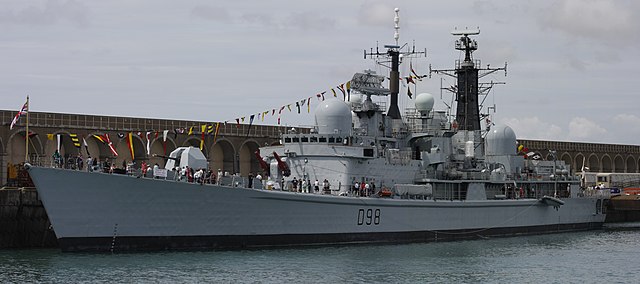
She was ordered at Swan Hunter Ltd, Wallsend-on-Tyne on 25 April 1979, laid down 18 January 1980, launched 21 June 1982 and completed on 25 March 1985, commissioned on 9 August 1985. York was the last Type 42 ordered and displayed the White Rose of York (“red cross with lions passant”) with Norman motto “bon espoir” as funnel badge. On trials she reached 34 knots (63 km/h; 39 mph); becoming Royal Navy’s fastest missile destroyer. By the summer of 1990, she was on routine patrol in the Persian Gulf (Armilla Patrol) and from 2 August with the invasion of Kuwait her trip to Australia to show the flag was cancelled as she stayed for three months in the Persian Gulf with round the clock watch. After refit at Rosyth by June 1995 she trained to full readiness and returned to the Far East and Middle East, stopping in Malaysia, Bangladesh, Oman, UAE, Kuwait, Saudi Arabia and Qatar on her way.
By 2002 she was deployed after the 9-11 bombings, relieving HMS Southampton and took station in the Gulf. She visited Salala oman, Dubai, Mumbai India, Gibraltar, Greece and Crete and back to Portsmouth in June. By 2003, York took part in the invasion of Iraq, providing cover for HMS Ark Royal. In 2004 she receiced the mark 8 4.5-inch gun like Edinburgh.
In July 2006 she sailed with Gloucester, evacuating British citizens from Beirut during the Israel-Lebanon conflict and transported evacuees to Cyprus.
In February 2010 with the RFC Wave Ruler she returned in the Falkland Islands and Argentina planned to dril for oil in the waters around the islands.
In February 2011, she was in Malta for the evacuation of British nationals from Libya. By 21 April she returned to the East Cove Military Port, Falklands, for patrol duties and by 12 December 2011, shadowed Admiral Kuznetsov off Orkney and for a week. A rare deployement, to thee top of Scotland and north Atlantic, flew over by Sukhoi Su-33 Flanker, Kamov Ka-27 helicopters.
By 13 April 2012, she fired her Sea Dart for the last time and entered Portsmouth on 20 September 2012, decommissioned on 27 September 2012, sold for scrap on August 2012.
 D96 Gloucester
D96 Gloucester

HMS Gloucester was ordered to Vosper Thornycroft on 27 March 1979, laid down 29 October 1979, launched 2 November 1982, completed 16 May 1985 and commissioned on 11 September 1985. In January 1987 she made her first deployment in the Persian Gulf as part of Operation Armilla, policing the Strait of Hormuz and stopping in Djibouti City, Sharjah, Manama, Karachi, Mombasa, Naples when back by June 1987. In January 1988 she made another round of the same, and visited Bahrain, Dubai, Rhodes. By April 1989 she was in drug patrol, West Indies and ended with visits at Long Beach, San Francisco and West Palm Beach. She took part in the 1st Gulf War, 1991, under Cap. Philip Wilcocks, shooting down an Iraqi Silkworm missile targeting USS Missouri and it was a first.
Unlike the US ships she did not fired her firing chaff to get clear contect, but made a hard turn, and fired two Sea Darts in 89 seconds of engagement. Later she avoided two naval mines, made several boardings while her Lynx helicopter destroyed Iraqi warships, FACs, minelayer, Polnocny-class landing ship, all with Sea Skuas. Later for the long service and kills, both captain Philip Wilcocks and flight commander Lt Cdr David Livingstone were awarded the DSO, and she was nicknamed “The Fighting G” in rememberance of the other Town-class HMS Gloucester sunk by May 1941 not far away.
In 1997 she took part in Ocean Wave 97 over 8 months, stopping in Australia, New Zealand, Singapore, UAE and was in rhz Five Power Defence Arrangements Exercise Flying Fish. She escorted Task Group 327.01 (Rear Admiral Alan West, flag HMS Illustrious) for the peaceful handover of Hong Kong.
The 2006 Israel-Lebanon was saw her evacuating British nationals from Beirut, and other evacuees to Cyprus. She had a last refit at Rosyth by 2007. On 26 August 2010 she intercepted the yacht Tortuga while going back from the Falklands, with £4 million of cocaine aboatd. By May 2011, she took part in Exercise Saxon Warrior against Carrier Strike Group 2, USS Truxtun and Mitscher as hostile force. In Portsmouth she was decommissioned on 30 June 2011, sold and towed in Turkey on 22 September 2015.
 D97 Edinburgh
D97 Edinburgh
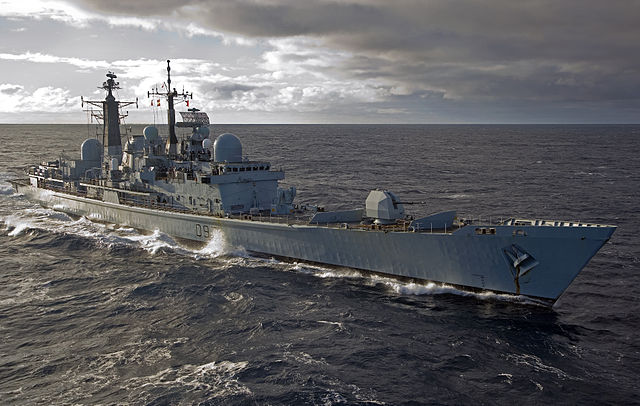
HMS Edinburgh was ordered at Cammell Laird on 25 April 1979, laid down on 8 September 1980, launched 13 April 1983, completed on 25 July 1985 and commissiond on 17 December 1985. No records before 1990, and in short:
1990, refit complete. 1994, Fleet Review, 50th D-Day landings. 1998, South Atlantic patrol, Falkland Islands and ports visits. 2002, escorted yachts in the Mersey end of the Clipper Round the World Yacht Race. January 2003 Persian Gulf, Second Gulf War, support Royal Marines ashore, escort HMS Ocean, back Portsmouth in May. April 2004, Standing Naval Force Mediterranean, Operation Active Endeavour. Refit in Rosyth. Exercise Neptune Warrior (Scotland), Sea Dart trials, Ex. BALTOPS in Baltic Sea, ports visits. Autumn 2006 Falkland Patrols until mid-2007. “Sea Swap” trial (swapping crews with HMS EXETER and EDINBURGH). 25th anniversary liberation Falklands June 2007, ports visits.
Middle and Far East from February until July 2008: Orion 2008. Last refit at Portsmouth under £17.5 million contract. Sea trials Sept. 2010. April 2011 Sea-Dart trials. May 2011 8-month deployment Cape Verde, Falkland. April 2012 last Sea Dart fire. 7 May 2013 Pool of London, farewell tour, back to Portsmouth for decommissioning, open to public in June, decommissioned on 6.
Conversion into museum proposed. No funding. Sold for BU in Turkey.


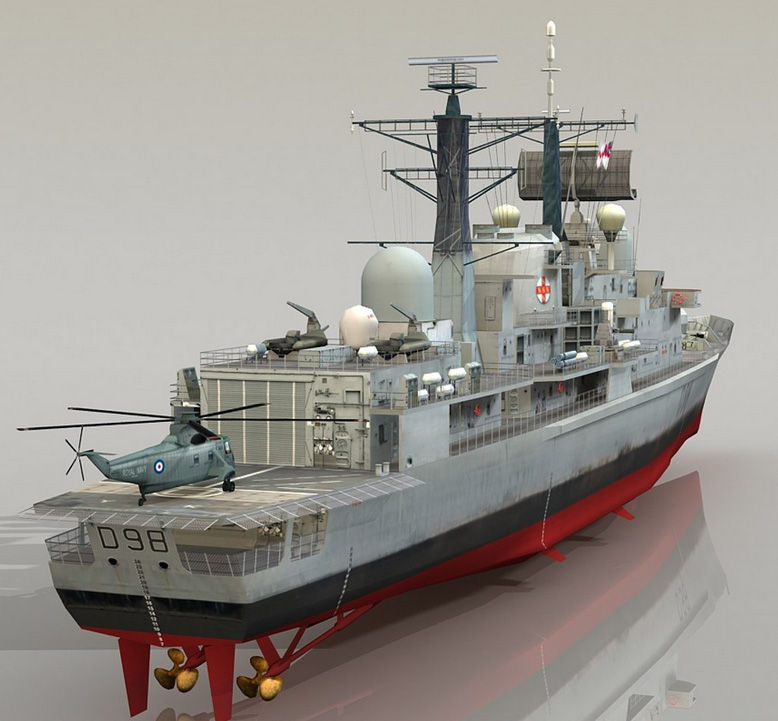
 Latest Facebook Entry -
Latest Facebook Entry -  X(Tweeter) Naval Encyclopedia's deck archive
X(Tweeter) Naval Encyclopedia's deck archive Instagram (@navalencyc)
Instagram (@navalencyc)





 French Navy
French Navy Royal Navy
Royal Navy Russian Navy
Russian Navy Armada Espanola
Armada Espanola Austrian Navy
Austrian Navy K.u.K. Kriegsmarine
K.u.K. Kriegsmarine Dansk Marine
Dansk Marine Nautiko Hellenon
Nautiko Hellenon Koninklije Marine 1870
Koninklije Marine 1870 Marinha do Brasil
Marinha do Brasil Osmanlı Donanması
Osmanlı Donanması Marina Do Peru
Marina Do Peru Marinha do Portugal
Marinha do Portugal Regia Marina 1870
Regia Marina 1870 Nihhon Kaigun 1870
Nihhon Kaigun 1870 Preußische Marine 1870
Preußische Marine 1870 Russkiy Flot 1870
Russkiy Flot 1870 Svenska marinen
Svenska marinen Søværnet
Søværnet Union Navy
Union Navy Confederate Navy
Confederate Navy Armada de Argentina
Armada de Argentina Imperial Chinese Navy
Imperial Chinese Navy Marinha do Portugal
Marinha do Portugal Mexico
Mexico Kaiserliche Marine
Kaiserliche Marine 1898 US Navy
1898 US Navy Sovietskiy Flot
Sovietskiy Flot Royal Canadian Navy
Royal Canadian Navy Royal Australian Navy
Royal Australian Navy RNZN Fleet
RNZN Fleet Chinese Navy 1937
Chinese Navy 1937 Kriegsmarine
Kriegsmarine Chilean Navy
Chilean Navy Danish Navy
Danish Navy Finnish Navy
Finnish Navy Hellenic Navy
Hellenic Navy Polish Navy
Polish Navy Romanian Navy
Romanian Navy Turkish Navy
Turkish Navy Royal Yugoslav Navy
Royal Yugoslav Navy Royal Thai Navy
Royal Thai Navy Minor Navies
Minor Navies Albania
Albania Austria
Austria Belgium
Belgium Columbia
Columbia Costa Rica
Costa Rica Cuba
Cuba Czechoslovakia
Czechoslovakia Dominican Republic
Dominican Republic Haiti
Haiti Hungary
Hungary Honduras
Honduras Estonia
Estonia Iceland
Iceland Eire
Eire Equador
Equador Iran
Iran Iraq
Iraq Latvia
Latvia Liberia
Liberia Lithuania
Lithuania Mandchukuo
Mandchukuo Morocco
Morocco Nicaragua
Nicaragua Persia
Persia San Salvador
San Salvador Sarawak
Sarawak Uruguay
Uruguay Venezuela
Venezuela Zanzibar
Zanzibar Warsaw Pact Navies
Warsaw Pact Navies Bulgaria
Bulgaria Hungary
Hungary

 Bundesmarine
Bundesmarine Dutch Navy
Dutch Navy Hellenic Navy
Hellenic Navy Marina Militare
Marina Militare Yugoslav Navy
Yugoslav Navy Chinese Navy
Chinese Navy Indian Navy
Indian Navy Indonesian Navy
Indonesian Navy JMSDF
JMSDF North Korean Navy
North Korean Navy Pakistani Navy
Pakistani Navy Philippines Navy
Philippines Navy ROKN
ROKN Rep. of Singapore Navy
Rep. of Singapore Navy Taiwanese Navy
Taiwanese Navy IDF Navy
IDF Navy Saudi Navy
Saudi Navy Royal New Zealand Navy
Royal New Zealand Navy Egyptian Navy
Egyptian Navy South African Navy
South African Navy






























 Ukrainian Navy
Ukrainian Navy dbodesign
dbodesign